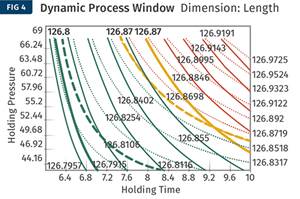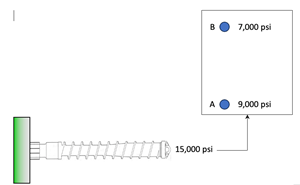Thermoplastic Composites at NPE2018: Machinery and Equipment
Machinery and equipment at NPE2018 developed specifically for the fabrication of thermoplastic composites.
Increased use of thermoplastic composites will, almost certainly, depend on machinery and manufacturing processes that can make it adaptable for high-volume, high-speed applications. Several equipment suppliers are leading the charge and have technology at NPE2018 highlighting capability.
Four manufacturers have been particularly active in developing systems that adapt traditional plastics processes, like injection molding, to integrate use of continuous fiber preforms. At NPE, KraussMaffei’s (Booth W403) process, FiberForm, is being demonstrated in combination with swivel plate technology for multi-component injection molding on a GXW 450-2000/1400 machine. FiberForm combines the thermoforming of composite sheets and injection in a single molding process. The resulting fiber-reinforced plastic components are particularly lightweight, but offer strength made possible by continuous fiber reinforcement. Paul Caprio, president of Kentucky-based KraussMaffei Corp., notes, “Our customers appreciate the high quality, reliability and cost-efficiency when manufacturing fiber-reinforced lightweight components in large quantities and fast cycle times."
Engel (Booth W3303) is similarly combining continuous fiber preforms with injection molding to create high-strength, high-volume hybridized structures. Engel recently worked with CCP Gransden to adapt an Engel vduo 1100 workcell for high-volume composites manufacturing. The workcell combines thermal-press forming and injection molding to achieve single-stage composite overmolding. The process begins with a reinforced thermoplastic blank (organosheet) that is heated in an infrared. The heated blank is then transferred to the press tool using a multi-axis robot. When the press closes to complete the thermal press forming process, the injection molding unit simultaneously injects a shot of thermoplastic resin. CCP Gransden has worked with PEEK, PEKK and PA.
Injection molding machinery supplier Arburg (Booth W1325) is featuring another hybrid process, called fiber direct compounding (FDC). The FDC unit on the injection unit includes a side feeder through which continuous glass rovings enter the barrel. The rovings are cut by an integrated cutter and then enter an adapted cylinder featuring a specialized screw. The fiber length, fiber content, and material combination can be adjusted to targeted specific component properties. At NPE, a hydraulic Allrounder 820 S will produce two 11.6-oz airbag housings in a cycle time of 70 seconds. A weight monitor integrated into the automation system displays the consistency of the shot weight and the finished parts are placed in boxes by a Multilift V linear robotic system.
Roctool (Booth S17013) offers several products, based on its induction heating technology, designed for use in composites fabrication, mostly targeted toward the high-speed/high-volume consumer electronics market. Light Induction Tooling (LIT) uses shell tooling with induction heating which allows high heat and cooling ramps while maintaining high temperature uniformity on the mold surface. Induction Dual Heating (IDH), developed with Arburg, offers induction-based mold heating for overmolding of carbon fiber preforms. 3iTech Heat & Cool helps ease design of mold heating and cooling layout to provide fast and homogeneous heating. The system uses flexible inductors that allow designers to follow any shape of tooling, using standard steel or Invar. A high-frequency current runs through the inductors to heat up the mold surface. Standard cooling channels with water are used to reduce mold temperature.
Related Content
Optimizing Pack & Hold Times for Hot-Runner & Valve-Gated Molds
Using scientific procedures will help you put an end to all that time-consuming trial and error. Part 1 of 2.
Read MoreThree Key Decisions for an Optimal Ejection System
When determining the best ejection option for a tool, molders must consider the ejector’s surface area, location and style.
Read MoreUsing Data to Pinpoint Cosmetic Defect Causes in Injection Molded Parts
Taking a step back and identifying the root cause of a cosmetic flaw can help molders focus on what corrective actions need to be taken.
Read MoreUnderstanding the Effect of Pressure Losses on Injection Molded Parts
The compressibility of plastics as a class of materials means the pressure punched into the machine control and the pressure the melt experiences at the end of fill within the mold will be very different. What does this difference mean for process consistency and part quality?
Read MoreRead Next
For PLASTICS' CEO Seaholm, NPE to Shine Light on Sustainability Successes
With advocacy, communication and sustainability as three main pillars, Seaholm leads a trade association to NPE that ‘is more active today than we have ever been.’
Read MorePeople 4.0 – How to Get Buy-In from Your Staff for Industry 4.0 Systems
Implementing a production monitoring system as the foundation of a ‘smart factory’ is about integrating people with new technology as much as it is about integrating machines and computers. Here are tips from a company that has gone through the process.
Read MoreSee Recyclers Close the Loop on Trade Show Production Scrap at NPE2024
A collaboration between show organizer PLASTICS, recycler CPR and size reduction experts WEIMA and Conair recovered and recycled all production scrap at NPE2024.
Read More












